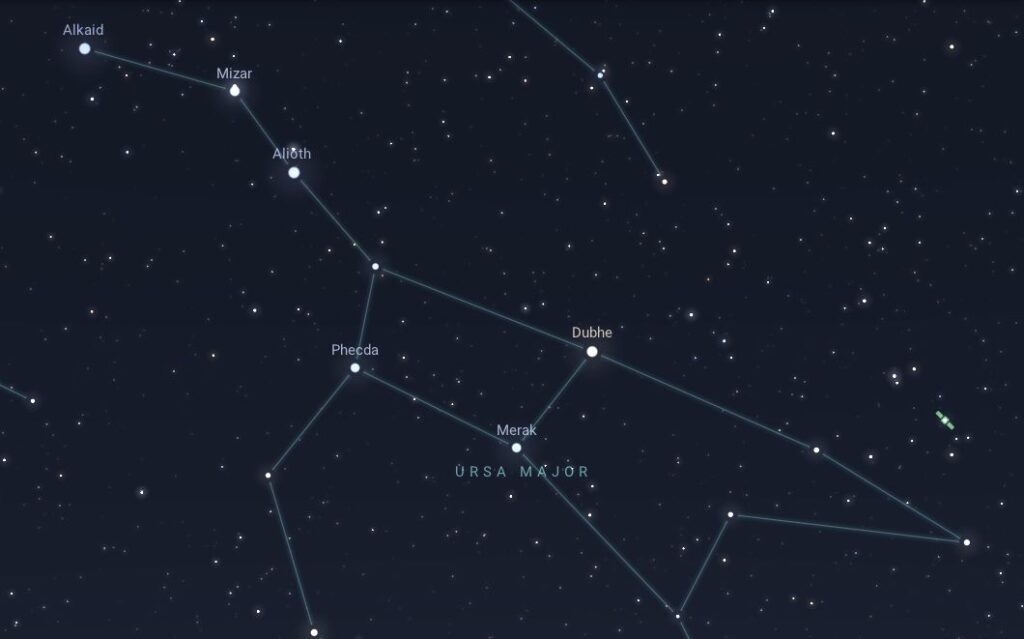The constellation Ursa Major, often referred to as the Great Bear or the Big Dipper, is one of the most prominent and recognizable constellations in the night sky, especially in the northern hemisphere. The constellation is formed by seven bright stars that appear to form the shape of a ladle or dipper. Here are some key details about Ursa Major:
Visibility
Ursa Major is visible throughout the year in the northern hemisphere and is circumpolar, meaning it never sets below the horizon for observers at high latitudes. Its visibility varies with the seasons, but it is generally most prominent in the spring and summer months. It coordinates in the night sky are:
Right Ascension (RA): Approximately 8h 00m to 15h 30m
Declination (Dec): Approximately +30° to +80°
These positional coordinates are used to pinpoint the location of astronomical objects on the celestial sphere. RA is analogous to longitude on Earth, measuring an object’s east-west position in the sky relative to the vernal equinox and expressed in hours, minutes, and seconds. Declination, similar to latitude, measures an object’s north-south position relative to the celestial equator and is expressed in degrees. Together, these coordinates provide an exact location for stars, constellations, and other celestial objects, allowing astronomers to track and observe them with precision.
Shape and Stars
Ursa Major is known for its distinctive shape, which resembles a large saucepan or ladle. It contains several bright stars that form the outline of the bear’s body and tail. The most recognizable feature of Ursa Major is the Big Dipper, a prominent asterism formed by seven bright stars that appear to form the shape of a dipper or ladle. The stars range in distance from about 79 light-years (Merak) to 124 light-years (Dubhe) from earth.
For centuries, these stars have served as a vital navigational tool for sailors, travellers, and explorers. The two outermost stars in the Big Dipper’s bowl, Dubhe and Merak, point directly toward the North Star, Polaris, making them essential for determining north.

Mythology
Ursa Major has been recognized and named by many cultures throughout history. In Polynesian mythology, it is known as Hokule’a, representing a canoe that carried the gods across the ocean. In Native American mythology, the stars of the Big Dipper are often associated with various animals and figures, depending on the tribe
Deep Sky Objects
The constellation is home to several notable deep sky objects, including the Pinwheel Galaxy (M101), the Owl Nebula (M97), the Whirlpool Galaxy (M51), and Bode’s Galaxy (M81). These objects are popular targets for amateur astronomers and can be observed with telescopes under dark skies.
Observation
Ursa Major is a constellation visible all year-round in the Northern Hemisphere, but its position in the sky shifts with the seasons and time of night. During the spring and summer months, the Big Dipper region of the constellation appears high in the sky in the late evening and early morning hours. This is when it reaches its highest point, or culmination, making it particularly easy to observe and a striking feature of the season’s night sky.
In the fall and winter months, Ursa Major remains visible but may appear lower on the northern horizon, especially during the early evening. While still recognizable, its less prominent position can make it slightly harder to spot, particularly for observers in areas with obstructions like trees or buildings.
The best time to observe the Big Dipper is around midnight, as it tends to be at its most elevated position in the sky during this time. However, during its peak visibility in spring and summer, it can often be seen clearly throughout the night.

Star Magnitudes
Here are the magnitudes of some of the most well-known stars in Ursa Major:
Dubhe (Alpha Ursae Majoris): Dubhe is the second-brightest star in Ursa Major and serves as the “pointer” star to the North Star, Polaris. Its apparent visual magnitude is approximately 1.79.
Merak (Beta Ursae Majoris): Merak is the fifth-brightest star in Ursa Major and forms one of the stars of the Big Dipper’s bowl. Its apparent visual magnitude is approximately 2.37.
Phecda (Gamma Ursae Majoris): Phecda is the seventh-brightest star in Ursa Major and also forms one of the stars of the Big Dipper’s bowl. Its apparent visual magnitude is approximately 2.44.
Megrez (Delta Ursae Majoris): Megrez is the faintest star in the Big Dipper’s bowl and has an apparent visual magnitude of approximately 3.31.
Alioth (Epsilon Ursae Majoris): Alioth is the brightest star in Ursa Major and forms one of the stars of the Big Dipper’s handle. Its apparent visual magnitude is approximately 1.76.
Mizar (Zeta Ursae Majoris): Mizar is a famous double star system located in the handle of the Big Dipper. Its primary component, Mizar A, has an apparent visual magnitude of approximately 2.04.
Alkaid (Eta Ursae Majoris): Alkaid is the third-brightest star in Ursa Major and forms the tip of the Big Dipper’s handle. Its apparent visual magnitude is approximately 1.85.


